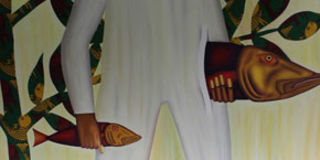A packed show, full of delights

Baracuda Series by Peter Ngugi, an artist at 1off gallery. PHOTO/FELIX NDUNGU
What you need to know:
- Originality, I feel, is a fairly important part of developing a voice.
- Birds of the fields are represented by three chickens in a large charcoal by Florence Wangui. She recently joined the One-Off stable and is getting better by the day.
- This is a shadowy and powerful work and could probably do with an end wall to itself but, in a packed show, full of delights, it becomes yet another reason to visit
The beasts of the air, the birds of the field and a few fishes thrown in... all the ingredients for an exhibition that should be a feast of some of the best art Kenya has to offer.
The beasts are actually humans (each to his own taste), appearing to float across a painting called Untitled with Sun by James Mbuthia, who seems to have turned into a cross between Marc Chagall and Cartoon Joseph.
Chagall is good — old enough and indeed, dead enough, to be fair game to copy.
But Cartoon Joseph is very much alive and probably kicking at the sight of the multi-coloured faces he pioneered being used by another artist to depict people who are of no tribe and of all tribes.
Originality, I feel, is a fairly important part of developing a voice.
Mbuthia is a talented artist but he badly needs, as they say, a new shtick.
This picture can be seen, with 11 others plus a couple of sculptures, at the One-Off Gallery in Rosslyn, Nairobi, where Carol Lees is holding a mixed exhibition of 14 of her contracted gallery artists (until September 25).
It is a roll call of some of the finest artists working in Kenya — Peterson Kamwathi, Ehoodi Kichape, Beatrice Wanjiku, Richard Kimathi, Mandy Bonnell, Timothy Brooke, Harrison Mburu…
But back to the birds of the field.
BIRDS OF THE FIELD
They are represented by three chickens in a large charcoal by Florence Wangui. She recently joined the One-Off stable and is getting better by the day.
Her drawing has always been adroit, but now her compositions are becoming ever more audacious, raising what many would see as a humdrum subject to the level of a symbol for the wonder of even small lives.
Here, in a picture bizarrely entitled Will Materialisation (blindingly well framed in white oak, incidentally) her three chickens form a strong diagonal across the sheet, the top one caught in flustered flight.
Wangui captures superbly the birds’ beady alertness and the surprising weight of their bone beneath the compact feathering.
Hung opposite the hens and balanced in size, medium and choice of frame, is a study by Peterson Kamwathi for the series of drawings and cut-outs he showed recently at the Frost Museum in Miami.
It is a large charcoal view of the backs of two demonstrators who hold aloft placards. Anyone looking at the picture faces the same way as the demonstrators and is drawn into the protest — audience involvement that is subtle but inevitable.
FISH OF THE SEA
And the fishes? They are, apparently, barracudas and appear in a huge painting by Peter Ngugi; so big it seems larger than the wall on which it is hung.
I associate Ngugi with pictures of stylised wild animals, each about the size of a mouse pad, but of late he has enlarged his scale. Massively.
But to what point I cannot tell. This painting shows a life-sized man with a solemn face holding a fish and the background is a tree carefully cut from cloth and stuck to the surface. Why, I have no idea.
In this apparent vacuity, it is perfectly matched by its neighbour, another large painting, this time by Peter Elungat. It is typical of his work in that it is of a floaty, vaguely medieval figure of a woman with a pin sized head. For sure it is detailed, carefully finished and decorative but to me that seems to be all it is.
Another artist noted for the quality of his finish is Richard Kimathi, although in his case his paintings — of mischievous animals or deadpan humanoids — are loaded with meaning and their immaculate surfaces belie the intensity of his message, creating a delayed drop effect as the meaning begins to sink in, slowly.
Occasionally he ventures into the descriptive (his series of rain paintings was one example; each raindrop a piece of coloured wool threaded through the canvas) and here he offers a lake of lillies.
Each white head is a circle of cloth, cut and glued to the canvas.
PICTURE OF MYSTERY
The effect is lyrical and hypnotic… a mysterious picture that could live on the wall for a very long time.
Timothy Brooke shows a view of the Mara plain, economical and carrying the smell of the savannah, while Ehoodi Kichape’s screaming skull is hung in splendid contrast next to a pair of spare and elegant flower etchings by Mandy Bonnell.
Nearby ghostly figures rear darkly into view in Shabu Mwangi’s work Judiciary, while at the other end of the gallery Harrison Mburu’s lion’s head in bas relief bursts off the wall like sunshine.
Almost opposite is Beatrice Wanjiku’s looming red and black picture The Strangeness of Madness.
This is a shadowy and powerful work and could probably do with an end wall to itself but, in a packed show, full of delights, it becomes yet another reason to visit.
The article first appeared in the East African.




